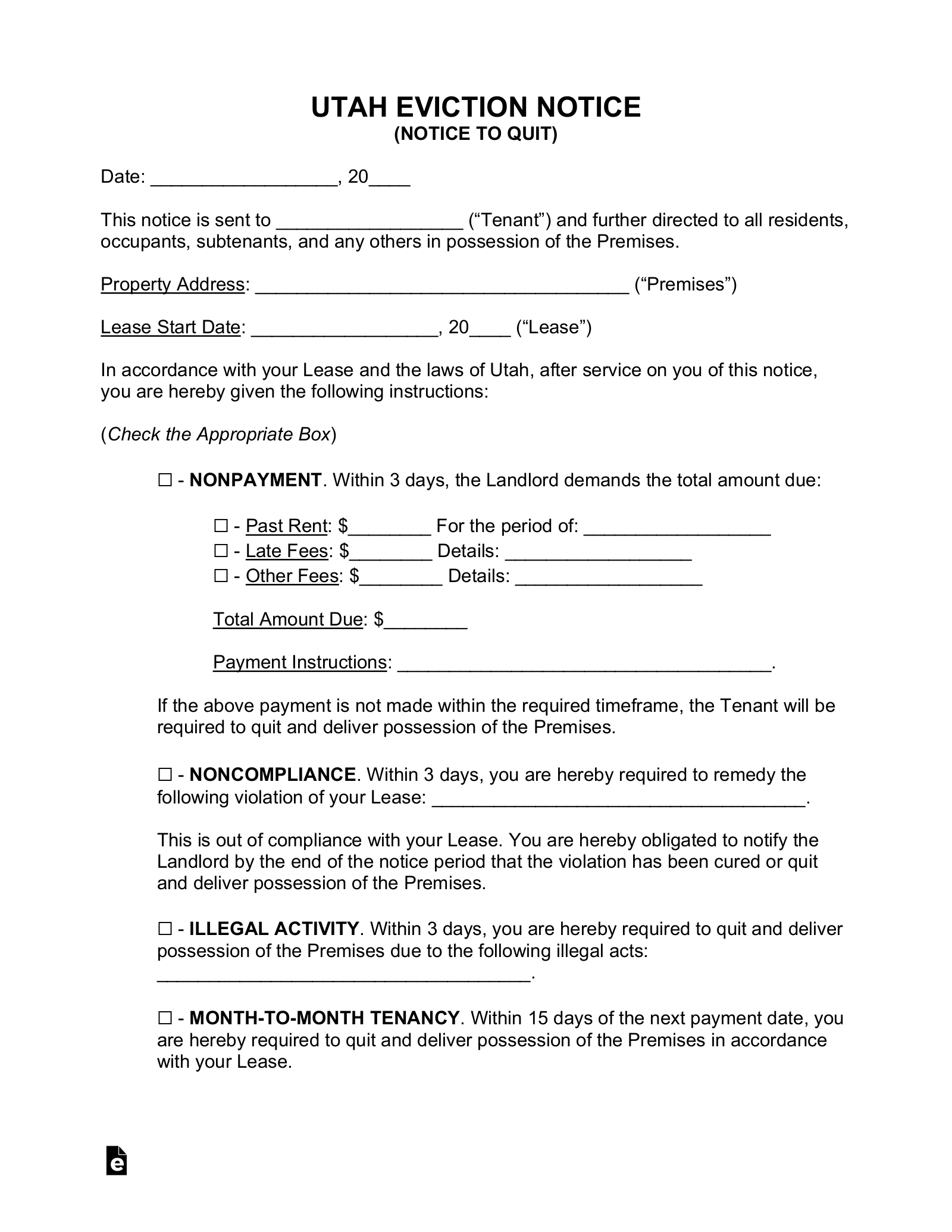Updated April 05, 2024
A Utah eviction notice is given to tenants by landlords when a lease violation has occurred. The notice should include the offense committed and the required time period for the tenant to respond. If the tenant is unresponsive, an eviction lawsuit (“Forcible Entry and Detainer”) can be filed at the local district court.
By Type (4)
 3-Day Notice to Quit (Non-Payment of Rent) – This lets the tenant know that they are behind in their rent and that they must pay or leave within three days. 3-Day Notice to Quit (Non-Payment of Rent) – This lets the tenant know that they are behind in their rent and that they must pay or leave within three days.
Download: PDF |
 3-Day Notice to Quit (Non-Compliance) – This form lets the tenant know that they are in breach of the lease, other than for non-payment, and that they must cure the breach or leave within three days. 3-Day Notice to Quit (Non-Compliance) – This form lets the tenant know that they are in breach of the lease, other than for non-payment, and that they must cure the breach or leave within three days.
Download: PDF |
3-Day Notice to Quit (Illegal Activity) – This is similar to the above in that the tenant has to leave in three days due to illegal activity on the premises. – This is similar to the above in that the tenant has to leave in three days due to illegal activity on the premises.
Download: PDF |
 15-Day Notice to Quit (Month-to-Month Tenancy) – This form is for use when there is a month-to-month tenancy in place, and one party does not intend to renew. This lets the other party know of the intention not to renew. 15-Day Notice to Quit (Month-to-Month Tenancy) – This form is for use when there is a month-to-month tenancy in place, and one party does not intend to renew. This lets the other party know of the intention not to renew.
Download: PDF |
Table of Contents |
Court Forms
Landlords in Utah will need to contact the District Court where the property is located to obtain the paperwork necessary to file for an eviction. Alternatively, landlords may utilize the Self-Help Document Producing Site to prepare their eviction filings.
Complaint – A petition filed by the landlord to initiate the eviction process. Before submitting this form, the landlord must provide the tenant with a written notice to quit which states the reason for the eviction as well as the number of days they have to either cure the issue or vacate.
Summons – Served upon the tenant to inform them of the amount of time they have to file a response to the eviction action.
Answer Form – After a Summons is served to a tenant, the individual may respond to the court by filing an Answer Form that states whether or not the tenant agrees to the allegations.
Order of Restitution – Issued by a judge after ruling in favor of a landlord in an eviction lawsuit. This document orders the tenant to vacate the premises within a specific number of days.
How to Evict a Tenant (5 steps)
- Provide Notice to Tenant
- File Summons and Complaint with Local Court
- Serve Summons and Complaint on Tenant
- Wait for Tenant’s Answer
- Receive Court Judgment
1. Provide Notice to Tenant
The first step in the eviction process is to provide the tenant with requisite notice that they are in breach of the lease and must fix the problem or move out. The landlord may not continue with eviction proceedings until the time period specified in the notice has been exhausted. The types of notices are as follows:
2. File Summons and Complaint with Local Court
If the tenant fails to cure the breach and/or fails to vacate the premises, the landlord may proceed to the Local District Court to file a Summons and Complaint for eviction. In Utah, the court system has a Self-Help Document Producing Site that you can use to create the documents you need.
The filing fee varies depending on the total value of the case.[8]
- Less than $2,000: $90 filing fee
- Between $2,000 and $10,000: $200 filing fee
- More than $10,000: $375 filing fee
3. Serve Summons and Complaint on Tenant
After you have prepared and filed the Summons and the Complaint, you must ensure that the tenant is properly served. You cannot serve the tenant yourself. You will have to have a sheriff or someone else complete service, and you must have evidence of the service to file with the court.
4. Wait for Tenant’s Answer
The tenant will have the right to defend themselves and reply to the court (usually within three days of being served) by using the Answer Form. This may also be filled in using the Self-Help Website provided by the state.


